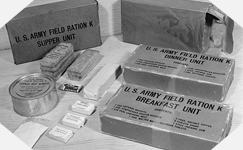K-ration – Combat food ration
History, technical sheet and photo

K-ration history
The K-ration is the individual and daily ration of the American soldier during the Second World War. It was developed in 1941 under the direction of the physiologist Ancel Keys (hence the name K), which receives as mission from the US Air Force to develop a non-perishable ration directly ready to eat and which holds In a soldier’s pocket. The American battle dress M-1943 herringbone twill (HBT) is thus made with large pockets able to contain this ration.
The rationing principle is to provide three meals (breakfast, lunch and dinner) to the soldier in the field when the supply chain is not yet in place or when food is not available At the premises. During an assault phase such as the Battle of Normandy, with the dropping of parachutists into enemy territory, the importance of this ration is vital for the soldier to be able to act in duration in combat. The first meal boxes are nicknamed “paratroopers rations” because they are the first to perceive them. In an ideal situation, soldiers should not live with rations for more than a fortnight.
After having searched a local supermarket for inexpensive energy products, Ancel Keys tested first daily rations of 2,830 to 3,000 calories depending on the ingredients used by soldiers who follow their daily routine activities.
In May 1942, the distribution of these rations weighing 2.4 kg each, this generalized to all the troops of the infantry. Despite some criticisms (notably from the mountain or jungle units), considering this ration unsuitable for intense efforts because too little caloric, the ration K does not change and remains staffing throughout the duration of the Second World War.
The K-ration is contained in a cardboard box, in which three other cartons containing the Breakfast Unit, the Dinner Unit and the Supper Unit are included. The outer packaging is waterproof and the combat gas. Beginning in 1944, the packaging of the three meals changed color to differentiate them.
K-ration specification
Creator/user: United States of America
Endowment: 1942-1945
Composition of the breakfast (Breakfast unit): 1 can of ham, veal, eggs, biscuits, 1 bar of fruit paste, 1 bag of coffee, a pack of 4 cigarettes, chewing gum, 3 pieces of sugar, tablets of purification of Halazone water, 1 key to open the can.
Composition of the dinner (Dinner unit): 1 canned (cooked cheese, ham or ham and cheese), fighting biscuits, 15 bags of milk powder (first versions) then 5 caramels (next versions), a pack of 4 cigarettes, 3 pieces of sugar, salt, Matches, juice powder (lemon flavor at the start, orange in 1943 then grape in 1945), 1 key to open the can.
Composition of the supper (Supper unit): 1 canned chicken pâté, pork-carrots-apples, beef-pork or sausages, fighting biscuits, 1 small bar of chocolate, 1 bar of chocolate “Tropical Bar” (or sweets for the warm countries), Toilet paper, a pack of 4 cigarettes, 3 pieces of sugar, chewing gum, powdered or cube soup, 1 key to open the can.



